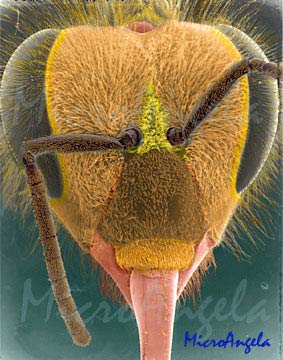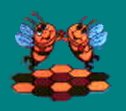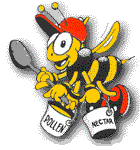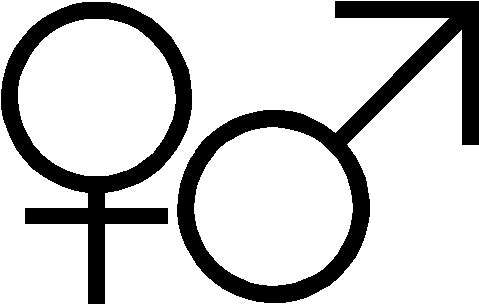
The Colony:
A Division of Labour At first glance a beehive appears to be a structure housing identical looking bees each living separate solitary lives with simply an extreme tolerance for living together. Of course this is not true. Not only do the bees willingly interact with each other to form a fully functional and precise community but the bees also differ structurally. There are three groups of bees. The

The Queen
The queen bee is the only fully developed female of the hive. Under normal circumstances she lays all of the eggs effectively insuring the continuation of the hive. Roughly speaking she pays no attention to the eggs after they are laid. The queen can be identified by her elongated thorax and slightly longer and thinner hind legs and is a sharp contrast to the drones.
The Drones
The drones appear in spring and early summer and are used for the fertilization of the queen's eggs. The drones are subject to ejection by their fellow bees after effectively becoming useless to the hive. The hive is maintained instead by the worker bees, the females. It is the workers who keep the hive functional.
The Workers
Worker bees are responsible for cleanliness, caring for the brood, or young, construction of combs and collection of food. This can be likened to maids, nannies, builders, and farmers within the labour force of mankind. Of course the analogy is a crude one but it helps to illustrate the social structure that is a honeybee hive. Studies have shown that any given bee does not hatch with one of the aforementioned tasks assigned to it, in fact the worker bees life involves most of the duties necessary for a functional hive. The life of the worker bee can be broken down into three stages.
Stage One
The first stage lasts from the first day to the tenth where she occupies the inside of the hive. Her task at this stage is to clean cells that have been vacated by newly emerged bees. She also works the cells over with her mandibles, or jaws. The queen bee can then lay her eggs in the cell. The bees activity then turns to that of a nursemaid. The bee sits on, or walks slowly around, brood cells to prevent cooling and ensure their warmth. Not only does the bee now keep the brood warm but biological changes are taking place. The bees feeding gland located in the head becomes fully developed. Using the hive's pollen stores as food intake the feeding gland gives essential proteins to the developing larvae. Studies have shown that a single worker bee can make a few thousand visits to a single brood cell to nurse a single larva. All tolled a worker bee at this stage has only enough time to nurse two to three larvae. As the end of this stage nears the worker bee venture outside the hive for the first time. Although the first flight away from "home" lasts only a few minutes it is an important step leading into further stages of the workers life, its duty outside the hive.
Stage Two
This stage lasts as long as the first, from about the tenth day to the twentieth of its life. Here the nursemaid function comes to an end, the bee leaves the brood to fulfill other duties. The wax glands are fully developed at this stage signaling the start of the building mode. Other responsibilities at this level are to digest the collected nectar and fill the appropriate storage cells with it. The bees also press down the "pollen baskets", with their mandibles, that the pollen collectors have brought in. Maintaining the cleanliness of the hive is also necessary as refuse and corpses of hive mates have to be disposed of. The unwanted material is simply picked up, flown to a reasonable distance, and dropped off accordingly. The final duty in this broad spectrum of tasks is protection of the hive. Near the end of the second stage groups of bees at this level guard the hive entrance. Examinations are given with the antennae in order to stop wasps and other honey stealers from entering the hive.
Stage Three
Once the bee has sufficiently fulfilled the house keeping duties it can now become a forager. During this third period, from around the twentieth day until death, the worker bee collects pollen and nectar from flowers. This is a dangerous time for the bee and because of this it is the final stage of the worker bees life. Most bees die within days of this stage with only a few living to be four to five weeks of age.
 Bee-home Again |
 Defensive Mechanisms |
 Dances with Bees |
 Foraging |
 Mating |